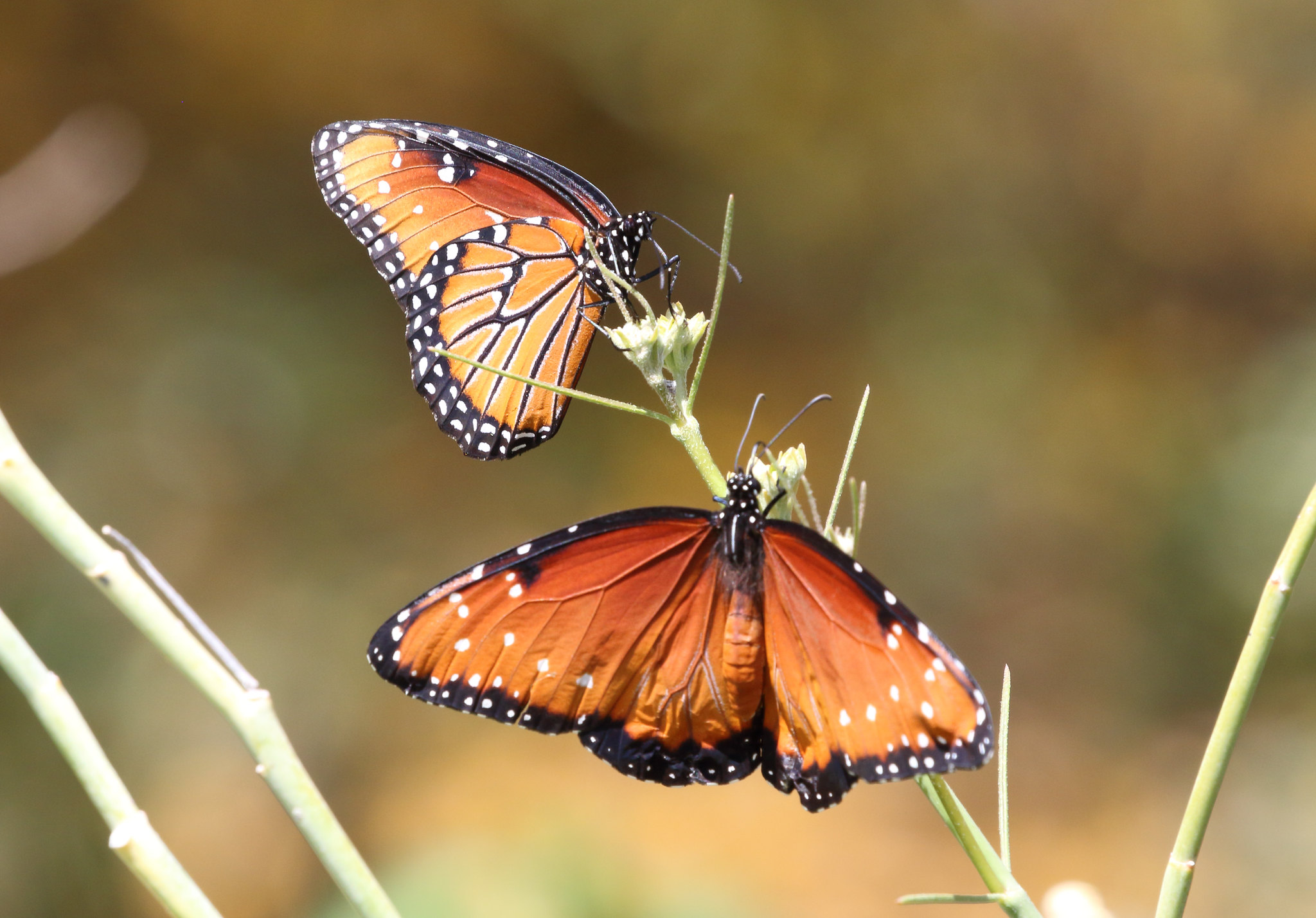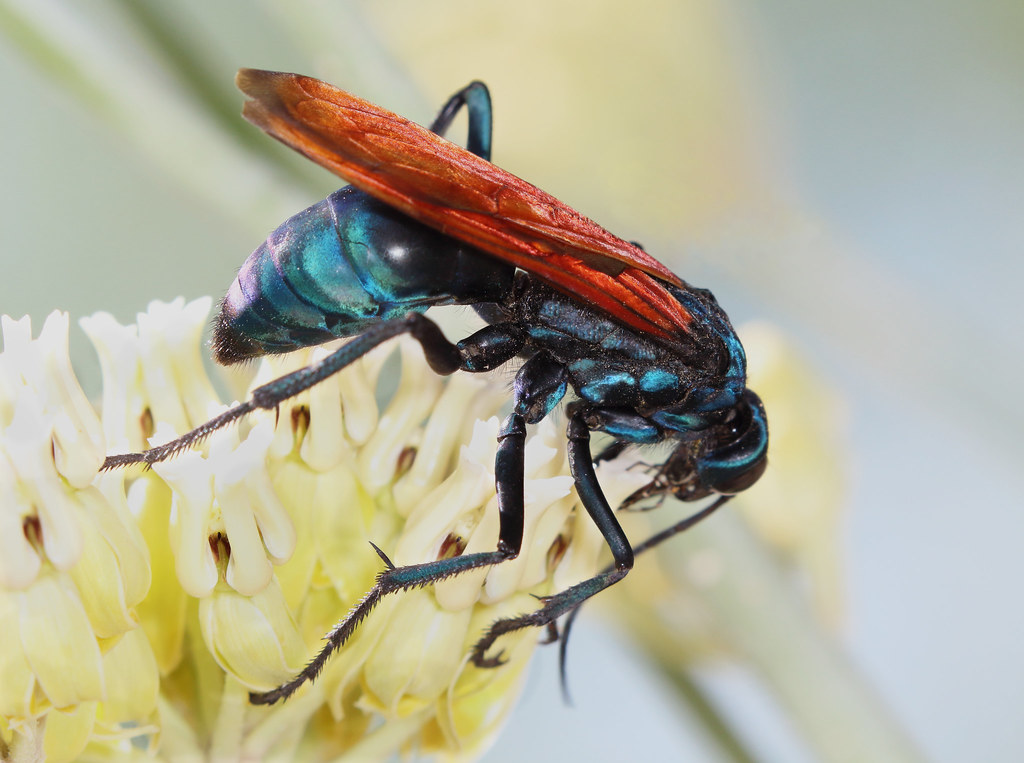Phoenix adventure 3: A mega-wasp and flaming dragons
Aug 25, 2019 21:54:47 #
More pictures from my visit to Phoenix, AZ last spring. I very much wanted to photograph dragonflies, as that is a chosen priority. The ones that I had seen so far were not interested in being photographed, so I decided to create more favorable odds. Any visitor to Phoenix would soon become aware of the Desert Botanical Garden in the city. I had visited this many years earlier, and I remember that it featured some ponds. The park of course had a highly diverse array of immaculately tended desert plants in full flower. Butterflies would be present, and maybe – just maybe -- a tarantula hawk would stop by for a feeding on those flowers. So I paid my admission and braved the crowds. Navigation past families and baby strollers was part of the game, but it turned out to be a terrific day!
I first made my way to the closest exhibits which featured many kinds of flowers. Among them were numerous queen butterflies ([i]Danaus gilippus). These are of course close relatives of the monarch butterfly.
 Queen butterflies by Mark Sturtevant, on Flickr
Queen butterflies by Mark Sturtevant, on Flickr
 Queen butterfly by Mark Sturtevant, on Flickr
Queen butterfly by Mark Sturtevant, on Flickr
 Queen butterfly by Mark Sturtevant, on Flickr
Queen butterfly by Mark Sturtevant, on Flickr
In the next pictures I show a buckeye butterfly (Junonia coenia), and a white peacock butterfly (Anartia jatrophae). This was a good start!
 Buckeye butterfly by Mark Sturtevant, on Flickr
Buckeye butterfly by Mark Sturtevant, on Flickr
 White peacock butterfly by Mark Sturtevant, on Flickr
White peacock butterfly by Mark Sturtevant, on Flickr
After wandering around among the flowers, I decided it was time to find the trails that would lead to the ponds. On my way I stopped to check directions with an attendant who was there to answer questions. She was a nice older lady, clearly one of the many retirees in Phoenix, and we got to talking about my wonky looking camera equipment and what the heck was it for. Once she understood that I was interested in all insects, not just dragonflies, she said “Oh, there was a large black bee over here a while ago”, and she pointed to a bunch of desert milkweed plants nearby. The “bee” on the flowers turned out to be an enormous tarantula hawk. Oh, my...
 Tarantula hawk by Mark Sturtevant, on Flickr
Tarantula hawk by Mark Sturtevant, on Flickr
Tarantula hawks are our largest wasp, and they are famous for preying on tarantulas; paralyzing them with a sting and feeding them to their larvae. Their sting is regarded as among the most painful, as is graphically demonstrated here by the crazy Coyote Peterson: https://www.youtube.com/watch?v=MnExgQ81fhU. What kind of health benefits does this guy get?
There are different species of these wasps, and I think this one is Pepsis thisbe. As you can see, she was extraordinarily beautiful but also very cooperative as she systematically explored every flower. So with heart pounding from great excitement, I continued to take picture after picture, hoping that my flash batteries would not fail.
 Tarantula hawk by Mark Sturtevant, on Flickr
Tarantula hawk by Mark Sturtevant, on Flickr
 Tarantula hawk by Mark Sturtevant, on Flickr
Tarantula hawk by Mark Sturtevant, on Flickr
Eventually, she and I were both ready to move on. By then we had a sizable crowd of on-lookers, so I told the people that when she flew off that they should just calmly stand still. Moments later she buzzed loudly away, and that was that. It was time to find those ponds!
There were many dragonflies that I very much wished to see. Among them would be the enormous giant darner (https://www.inaturalist.org/taxa/67732-Anax-walsinghami), and the strikingly unusual filigree skimmer (https://www.inaturalist.org/taxa/111055-Pseudoleon-superbus). But timing is everything and those species would not be flying at this time. But I had hopes to see the appropriately named flame skimmer dragonfly (Libellula saturata), and as you can see in the final pictures I certainly found them! Like most skimmers, they proved pretty easy to photograph.
 Flame skimmer dragonfly by Mark Sturtevant, on Flickr
Flame skimmer dragonfly by Mark Sturtevant, on Flickr
 Flame skimmer dragonfly by Mark Sturtevant, on Flickr
Flame skimmer dragonfly by Mark Sturtevant, on Flickr
 Flame skimmer dragonfly by Mark Sturtevant, on Flickr
Flame skimmer dragonfly by Mark Sturtevant, on Flickr
It was then getting late. Tired but very satisfied with this effort, I headed back to the hotel to prepare for the final full day.
I first made my way to the closest exhibits which featured many kinds of flowers. Among them were numerous queen butterflies ([i]Danaus gilippus). These are of course close relatives of the monarch butterfly.
 Queen butterflies by Mark Sturtevant, on Flickr
Queen butterflies by Mark Sturtevant, on Flickr Queen butterfly by Mark Sturtevant, on Flickr
Queen butterfly by Mark Sturtevant, on Flickr Queen butterfly by Mark Sturtevant, on Flickr
Queen butterfly by Mark Sturtevant, on FlickrIn the next pictures I show a buckeye butterfly (Junonia coenia), and a white peacock butterfly (Anartia jatrophae). This was a good start!
 Buckeye butterfly by Mark Sturtevant, on Flickr
Buckeye butterfly by Mark Sturtevant, on Flickr White peacock butterfly by Mark Sturtevant, on Flickr
White peacock butterfly by Mark Sturtevant, on FlickrAfter wandering around among the flowers, I decided it was time to find the trails that would lead to the ponds. On my way I stopped to check directions with an attendant who was there to answer questions. She was a nice older lady, clearly one of the many retirees in Phoenix, and we got to talking about my wonky looking camera equipment and what the heck was it for. Once she understood that I was interested in all insects, not just dragonflies, she said “Oh, there was a large black bee over here a while ago”, and she pointed to a bunch of desert milkweed plants nearby. The “bee” on the flowers turned out to be an enormous tarantula hawk. Oh, my...
 Tarantula hawk by Mark Sturtevant, on Flickr
Tarantula hawk by Mark Sturtevant, on FlickrTarantula hawks are our largest wasp, and they are famous for preying on tarantulas; paralyzing them with a sting and feeding them to their larvae. Their sting is regarded as among the most painful, as is graphically demonstrated here by the crazy Coyote Peterson: https://www.youtube.com/watch?v=MnExgQ81fhU. What kind of health benefits does this guy get?
There are different species of these wasps, and I think this one is Pepsis thisbe. As you can see, she was extraordinarily beautiful but also very cooperative as she systematically explored every flower. So with heart pounding from great excitement, I continued to take picture after picture, hoping that my flash batteries would not fail.
 Tarantula hawk by Mark Sturtevant, on Flickr
Tarantula hawk by Mark Sturtevant, on Flickr Tarantula hawk by Mark Sturtevant, on Flickr
Tarantula hawk by Mark Sturtevant, on FlickrEventually, she and I were both ready to move on. By then we had a sizable crowd of on-lookers, so I told the people that when she flew off that they should just calmly stand still. Moments later she buzzed loudly away, and that was that. It was time to find those ponds!
There were many dragonflies that I very much wished to see. Among them would be the enormous giant darner (https://www.inaturalist.org/taxa/67732-Anax-walsinghami), and the strikingly unusual filigree skimmer (https://www.inaturalist.org/taxa/111055-Pseudoleon-superbus). But timing is everything and those species would not be flying at this time. But I had hopes to see the appropriately named flame skimmer dragonfly (Libellula saturata), and as you can see in the final pictures I certainly found them! Like most skimmers, they proved pretty easy to photograph.
 Flame skimmer dragonfly by Mark Sturtevant, on Flickr
Flame skimmer dragonfly by Mark Sturtevant, on Flickr Flame skimmer dragonfly by Mark Sturtevant, on Flickr
Flame skimmer dragonfly by Mark Sturtevant, on Flickr Flame skimmer dragonfly by Mark Sturtevant, on Flickr
Flame skimmer dragonfly by Mark Sturtevant, on FlickrIt was then getting late. Tired but very satisfied with this effort, I headed back to the hotel to prepare for the final full day.
Aug 25, 2019 22:06:03 #
Aug 25, 2019 22:18:51 #
Nice! Did you see the milkweed pollinia on the front right tarsus of the last Pepsis shot? (Actually, I think it is on the middle tarsus, but hard to tell.) They are an important pollinator of milkweed because they are strong enough to pull the pollinia out of the flower when a claw or spur gets guided up the cleft to the anchor clasp (I've forgotten the name for the clasp). These show very well on the flower shots.
Aug 25, 2019 22:32:31 #
Aug 26, 2019 04:43:33 #
Aug 26, 2019 06:24:12 #
What an outstanding set Mark. Love the fine detail in the skimmers. I'm headed out there next week and hope to find some Odes to shoot. Some day I will get a Filligree Skimmer!
-Doc
-Doc
Aug 26, 2019 10:55:42 #
Aug 26, 2019 12:12:41 #
Wowzer! What a great series and the quality of your images are first-class. I always learn something from your posts and I look forward to each one.
On another note, I watched a fellow on YouTube that deliberately stings himself with notorious insects to rate the level and duration of pain that they cause and the Tarantula Hawk was extremely painful raking at the top of the pain index.
On another note, I watched a fellow on YouTube that deliberately stings himself with notorious insects to rate the level and duration of pain that they cause and the Tarantula Hawk was extremely painful raking at the top of the pain index.
Aug 26, 2019 12:25:40 #
sippyjug104 wrote:
On another note, I watched a fellow on YouTube that deliberately stings himself with notorious insects to rate the level and duration of pain that they cause and the Tarantula Hawk was extremely painful raking at the top of the pain index.
On another note, I watched a fellow on YouTube that deliberately stings himself with notorious insects to rate the level and duration of pain that they cause and the Tarantula Hawk was extremely painful raking at the top of the pain index.
That is Coyote Peterson. He is rather crazy.
Aug 26, 2019 13:13:04 #
Aug 26, 2019 13:28:38 #
Great shots. Here's what Wickipedia says about the sting of the tarantula wasp:
"Tarantula hawk wasps are relatively docile and rarely sting without provocation. However, the sting—particularly that of P. grossa—is among the most painful of all insects, though the intense pain only lasts about five minutes.[8] One researcher described the pain as "...immediate, excruciating, unrelenting pain that simply shuts down one's ability to do anything, except scream. Mental discipline simply does not work in these situations."[5] In terms of scale, the wasp's sting is rated near the top of the Schmidt sting pain index, second only to that of the bullet ant, and is described by Schmidt as "blinding, fierce[, and] shockingly electric".[2] Because of their extremely large stingers, very few animals are able to eat them; one of the few that can is the roadrunner. Many predatory animals avoid these wasps, and many different insects mimic them, including various other wasps and bees (Müllerian mimics), as well as moths, flies (e.g., mydas flies), and beetles (e.g., Tragidion) (Batesian mimics).
Aside from the possibility of triggering an allergic reaction, the sting is not dangerous and does not require medical attention. Local redness appears in most cases after the pain, and lasts for up to a week."
"Tarantula hawk wasps are relatively docile and rarely sting without provocation. However, the sting—particularly that of P. grossa—is among the most painful of all insects, though the intense pain only lasts about five minutes.[8] One researcher described the pain as "...immediate, excruciating, unrelenting pain that simply shuts down one's ability to do anything, except scream. Mental discipline simply does not work in these situations."[5] In terms of scale, the wasp's sting is rated near the top of the Schmidt sting pain index, second only to that of the bullet ant, and is described by Schmidt as "blinding, fierce[, and] shockingly electric".[2] Because of their extremely large stingers, very few animals are able to eat them; one of the few that can is the roadrunner. Many predatory animals avoid these wasps, and many different insects mimic them, including various other wasps and bees (Müllerian mimics), as well as moths, flies (e.g., mydas flies), and beetles (e.g., Tragidion) (Batesian mimics).
Aside from the possibility of triggering an allergic reaction, the sting is not dangerous and does not require medical attention. Local redness appears in most cases after the pain, and lasts for up to a week."
Aug 26, 2019 15:05:34 #
Aug 26, 2019 16:04:28 #
Aug 26, 2019 16:46:21 #
If you want to reply, then register here. Registration is free and your account is created instantly, so you can post right away.












